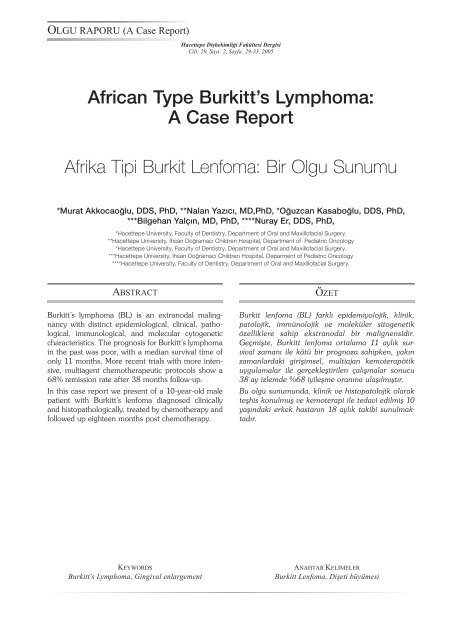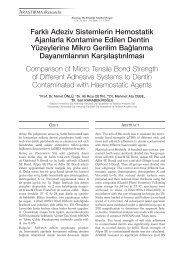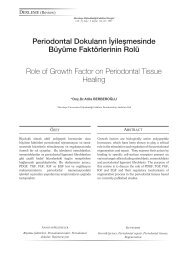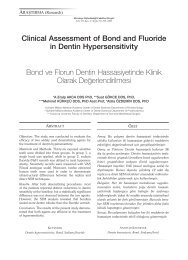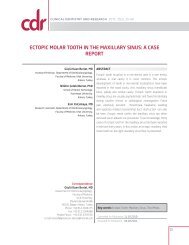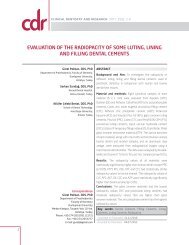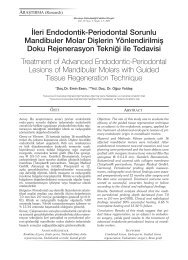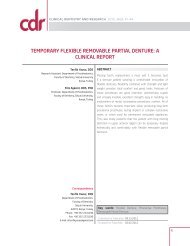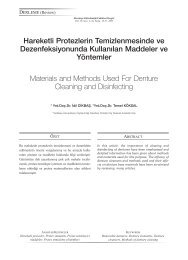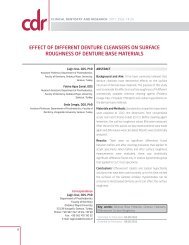African Type Burkitt's Lymphoma - dishekdergi.hacettepe.edu.tr
African Type Burkitt's Lymphoma - dishekdergi.hacettepe.edu.tr
African Type Burkitt's Lymphoma - dishekdergi.hacettepe.edu.tr
You also want an ePaper? Increase the reach of your titles
YUMPU automatically turns print PDFs into web optimized ePapers that Google loves.
OLGU RAPORU (A Case Report)<br />
ABSTRACT<br />
Burkitt’s lymphoma (BL) is an ex<strong>tr</strong>anodal malingnancy<br />
with distinct epidemiological, clinical, pathological,<br />
immunological, and molecular cytogenetic<br />
characteristics. The prognosis for Burkitt’s lymphoma<br />
in the past was poor, with a median survival time of<br />
only 11 months. More recent <strong>tr</strong>ials with more intensive,<br />
multiagent chemotherapeutic protocols show a<br />
68% remission rate after 38 months follow-up.<br />
In this case report we present of a 10-year-old male<br />
patient with Burkitt’s lenfoma diagnosed clinically<br />
and histopathologically, <strong>tr</strong>eated by chemotherapy and<br />
followed up eighteen months post chemotherapy.<br />
KEYWORDS<br />
Burkitt’s <s<strong>tr</strong>ong>Lymphoma</s<strong>tr</strong>ong>, Gingival enlargement<br />
Hacettepe Dişhekimliği Fakültesi Dergisi<br />
Cilt: 29, Sayı: 2, Sayfa: 29-33, 2005<br />
<s<strong>tr</strong>ong>African</s<strong>tr</strong>ong> <s<strong>tr</strong>ong>Type</s<strong>tr</strong>ong> Burkitt’s <s<strong>tr</strong>ong>Lymphoma</s<strong>tr</strong>ong>:<br />
A Case Report<br />
Afrika Tipi Burkit Lenfoma: Bir Olgu Sunumu<br />
*Murat Akkocaoğlu, DDS, PhD, **Nalan Yazıcı, MD,PhD, *Oğuzcan Kasaboğlu, DDS, PhD,<br />
***Bilgehan Yalçın, MD, PhD, ****Nuray Er, DDS, PhD,<br />
*Hacettepe University, Faculty of Dentis<strong>tr</strong>y, Department of Oral and Maxillofacial Surgery.<br />
**Hacettepe University, İhsan Doğramacı Children Hospital, Department of Pedia<strong>tr</strong>ic Oncology<br />
*Hacettepe University, Faculty of Dentis<strong>tr</strong>y, Department of Oral and Maxillofacial Surgery.<br />
***Hacettepe University, İhsan Doğramacı Children Hospital, Deparment of Pedia<strong>tr</strong>ic Oncology<br />
****Hacettepe University, Faculty of Dentis<strong>tr</strong>y, Department of Oral and Maxillofacial Surgery.<br />
ÖZET<br />
Burkit lenfoma (BL) farklı epidemiyolojik, klinik,<br />
patolojik, immünolojik ve moleküler sitogenetik<br />
özelliklere sahip eks<strong>tr</strong>anodal bir malignensidir.<br />
Geçmişte, Burkitt lenfoma ortalama 11 aylık survival<br />
zamanı ile kötü bir prognoza sahipken, yakın<br />
zamanlardaki girişimsel, multiajan kemoterapötik<br />
uygulamalar ile gerçekleştirilen çalışmalar sonucu<br />
38 ay izlemde %68 iyileşme oranına ulaşılmıştır.<br />
Bu olgu sunumunda, klinik ve histopatolojik olarak<br />
teşhis konulmuş ve kemoterapi ile tedavi edilmiş 10<br />
yaşındaki erkek hastanın 18 aylık takibi sunulmaktadır.<br />
ANAHTAR KELİMELER<br />
Burkitt Lenfoma, Dişeti büyümesi
30<br />
In<strong>tr</strong>ODUCtIOn<br />
Burkitt’s lymphoma (BL) is an ex<strong>tr</strong>anodal<br />
malingnancy with distinct epidemiological, clinical,<br />
pathological, immunological, and molecular<br />
cytogenetic characteristics. 1 Burkitt’s lymphoma<br />
is a malignancy of B-lymphocyte origin that represents<br />
an undifferentiated lymphoma. During<br />
the 1950s, Dennis Burkitt described rapidly<br />
growing jaw and abdominal lymphoid tumors<br />
in East <s<strong>tr</strong>ong>African</s<strong>tr</strong>ong> children. 2 The Tumor, Burkitt’s<br />
lymphoma, is the human cancer most closely linked<br />
with a virus. Ebstein-Barr virus is associated<br />
with 90% of <s<strong>tr</strong>ong>African</s<strong>tr</strong>ong> patients with BL, but this<br />
percentage is considerably lower for BL seen in<br />
other parts of the world. The reason for the association<br />
between BL and Ebstein-Barr virus remains<br />
unknown. 1-3 The peak age of the <s<strong>tr</strong>ong>African</s<strong>tr</strong>ong><br />
BL is between 5 and 7 years. The male to female<br />
ratio ranges between 2:1 and 6,5:1 and is much<br />
higher in patients under 13 with an incidence of<br />
0,1 to 0,3/100,000. 4<br />
The clinical presentation of BL is characterized<br />
by rapid progression of symptoms with frequent<br />
multifocal ex<strong>tr</strong>anodular involvement, including<br />
cen<strong>tr</strong>al nervous system involvement. With<br />
in the oral cavity, this tumour can progress very<br />
fast and appears as a facial swelling or exophytic<br />
mass involving the jaws. 5 Involvement of facial<br />
bones and oral cavity occurs in less than 30% of<br />
cases in most series. 6-7 The <s<strong>tr</strong>ong>African</s<strong>tr</strong>ong> form of BL<br />
most frequently manifests itself as rapidly growing,<br />
ex<strong>tr</strong>anodal jaw tumors in young children,<br />
but it also may be first detected as an abdominal<br />
involving the kidneys or ovaries. The growth<br />
of the tumor mass may produced facial swelling<br />
and propitosis. Pain, tenderness, and paresthesia<br />
are usually minimal, although marked tooth<br />
mobility may be present because of aggressive<br />
des<strong>tr</strong>uction of the alveoler bone. 2<br />
The radiographic features are consistent with<br />
a malignant process and include a radiolucent<br />
des<strong>tr</strong>uction of the bone with ragged, ill-defined<br />
margins. This process may begin as several<br />
smaller sites, which eventually enlarge and coa-<br />
lesence. Patchy loss of the lamina dura has been<br />
mentioned as an early sign of BL.<br />
BL histopathologically represents an undifferantiated,<br />
small, noncleaved B-cell lymphoma.<br />
The lesional tissue invades as broad sheets of<br />
tumor cells and exhibits round nuclei with several<br />
prominent nucleoli and numerous mitoses.<br />
A classic starry-sky pattern is associated with<br />
lesional tissue, aphenomenon that is caused by<br />
the presence of macrophages within the tumor<br />
tissue. Tumors with a similar histomorphology,<br />
commonly referred to as American Burkitt’s<br />
lymphoma, have been observed in other coun<strong>tr</strong>ies<br />
where the neoplasms usually first detected as<br />
an abdominal mass. 1,2<br />
BL lesions have a dramatic response to chemotheraphy,<br />
particularly cyclophosphamide.<br />
The tumor also has been shown to be sensitive to<br />
metho<strong>tr</strong>exate, vincristine, and cytarabine. Combinations<br />
of drugs have achieved remissions in<br />
more than 90% of patients. Unfortunately, most<br />
experience recurrences and ultimately die of their<br />
disease. The prognosis for Burkitt’s lymphoma<br />
in the past was poor, with a median survival time<br />
of only 11 months. More recent <strong>tr</strong>ials with more<br />
intensive, multiagent chemotherapeutic protocols<br />
show a 68% remission rate after 38 months<br />
follow-up.<br />
In this case report we present of a 10-year-old<br />
male patient with Burkitt’s lenfoma from Turkey<br />
diagnosed by gingival overgrowth, alveoler bone<br />
loss, tooth mobility and histopathologically, <strong>tr</strong>eated<br />
by chemotherapy and followed up eighteen<br />
months post chemotherapy.<br />
Case rePOrt<br />
A ten year old boy presented with a six week<br />
history of painful and progressive swelling of the<br />
jaw bilaterally. It was considered as dental abcess<br />
at the local hospital and antibiotic therapy was<br />
considered for two weeks.The lesions of the gingiva<br />
and the swelling of the jaw did not resolve.<br />
He had also headache, fever and weight loss. A<br />
gingival biopsy was performed at the local hospi-
tal and histopathological examination was reported<br />
as “chronic inflammatory process”.<br />
The patient admitted to our hospital with the<br />
same complaints in November 2002. Oral clinical<br />
examination revealed gingival overgrowth<br />
in both maxilla and mandible and marked tooth<br />
mobility. The marginal and attached gingivae in<br />
almost all teeth, on both buccal-labial palatal-lingual<br />
aspect, were severely inflamed, bright red in<br />
appearence, and hyperplastic (Figs 1 and 2).<br />
Initial physical examination showed a marked<br />
swelling of the mandibula bilaterally, facial edema<br />
and also swelling of the cheeks extending to<br />
the zygomatic arcus on the left. Two lymph nodes<br />
are palpable, each smaller than 0.5 cm in<br />
the right anterior cervical region. The rest of the<br />
physical examination was unremarkable.<br />
The orthopantomographic examination revealed<br />
alveolar bone resorption (Fig 3). A new<br />
FIGURE 1-2<br />
In<strong>tr</strong>aoral appereance of patient. Note the swellings and<br />
severely inflamed gingivae<br />
31<br />
biopsy was performed from the right lower gin-<br />
giva. Both the new biopsy and the previous one<br />
were reported as “ Burkitt’s lymphoma” (Fig 4).<br />
The initial laboratory examinations of the pa-<br />
tient were as follows: Hb:9.1 g/dl, WBC: 7800/<br />
mm 3 , platelets: 315.000/mm 3 with a normal dif-<br />
ferential; serum biochemis<strong>tr</strong>y was normal except<br />
a LDH of 1737 IU. Bone marrow examination<br />
revealed diffuse involvement by lymphoblasts;<br />
computerized tomography of the head showed<br />
lytic lesions on the right frontoparietal region<br />
with an epidural soft tissue component and skin<br />
involvement; also a left sphenoidal lytic lesion<br />
with a soft tissue mass extending to the anterior<br />
of the temporal lobe and the orbit ex<strong>tr</strong>aaxially<br />
FIGURE 3<br />
Panoramic radiograph demos<strong>tr</strong>ating bone defects and lytic<br />
areas on both jaws<br />
FIGURE 4<br />
Low magnification shows “starry sky” appearance due to<br />
interspersed macrophages with abundant cytoplasm and<br />
hyperchromatic neoplastic lymphoid cells
32<br />
FIGURE 5<br />
CT showing a left sphenoidal lytic lesion with a soft tissue mass<br />
extending to the anterior of the temporal lobe and the orbit<br />
ex<strong>tr</strong>aaxially<br />
FIGURE 6<br />
In<strong>tr</strong>aoral view after 1 year demos<strong>tr</strong>ating gingival healing and<br />
tooth eruption<br />
FIGURE 7<br />
Postchemotherapy panoramic radiograph showing the healing<br />
of bone lesions<br />
was detected (Fig 5). A thoracic and abdominal<br />
computerized tomography showed bilateral kidney<br />
lesions. The other bones except the facial<br />
ones were normal on plain X-rays. The cytological<br />
examination of cerebrospinal fluid was<br />
negative.<br />
With the diagnosis of stage IV Burkitt’s type<br />
non-Hodgkin’s lymphoma; we <strong>tr</strong>eated the patient<br />
with LMB-B chemotherapy regimen which included<br />
vincristine, cyclophosphamide, prednisolone,<br />
adriamycine, high dose metho<strong>tr</strong>exate with<br />
leucovorine rescue. The patient had a complete<br />
response to chemotherapy. In April 2003,<br />
chemotherapy was ended when the patient was<br />
in complete remission. He is still under regular<br />
follow-up with no evidence of disease eighteen<br />
months after cessation of <strong>tr</strong>eatment. Fig 6 and 7<br />
shows the post chemotherapy clinical and radiographic<br />
picture of normal tooth development.<br />
DIsCUssIOn<br />
Diagnosis of Burkitt’s lymphoma, especially<br />
when the sole presentation is in the maxillofacial<br />
region, is very difficult. The clinical presentation<br />
of the disease may mimic a wide variety of disorders<br />
more commonly found within the jaws. Because<br />
primary presentation of the disease is often<br />
in the mouth and jaws, a high index of suspicion<br />
is required from the medical staff in order to assure<br />
early diagnosis and a better prognosis of the<br />
disease. Clinical differential diagnosis of Burkitt’s<br />
lymphoma should include: acute dentoalveolar<br />
abscess 8 , osteomyelitis, rhabdomyosarcoma, periapical<br />
lesions, ameloblastoma, eosinophilic granuloma,<br />
multiple myeloma, leukemia, and other<br />
fibro-osseous lesions. The signs and symptoms<br />
of oral Burkitt’s lymphoma include mobile teeth,<br />
toothache, oral masses, gingival enlargement,<br />
pain, and jaw expansion. 5 Additional to all these<br />
findings Ugboko et al 9 reported a case with a lower<br />
lip paresthesia. BL is one of the most rapidly<br />
growing tumors, doubling in size every 24 hours.<br />
10 Because of its ex<strong>tr</strong>emely rapid growth rate,<br />
prompt diagnosis before the initiation of specific<br />
<strong>tr</strong>eatment is imperative for a favorable prognosis.
Alveolar bone resorption and lamina dura loss<br />
has been seen in radiological examination. In<br />
the literature, radiographic findings of the involved<br />
jaw have been well described by Burkitt, 11<br />
Adatia, 12-14 Hupp et al., 15 Wood et al., 16 Anavi et<br />
al., 17 and Hanazawa et al. 18 Our findings were similar.<br />
According to our experience, dentists and<br />
maxillofacial surgeons should evaluate oral and<br />
radiologic findings as facial swelling and gingival<br />
enlargement, alveoler bone loss with a suspect of<br />
BL considering the rapid growth rate and poor<br />
diagnosis.<br />
REFERENCES<br />
1. Liu RS, Liu HC, Bu JQ, Dong SN. Burkitt’s <s<strong>tr</strong>ong>Lymphoma</s<strong>tr</strong>ong><br />
Presenting With Jaw Lesions. J Periodontol. 2000;71:646-<br />
649.<br />
2. Neville BW, Damm DD, Allen CM, Bouquot JE. Oral<br />
and Maxillofacial Pathology. Philedelphia: W.B. Saunders<br />
Company; 1995:436-437.<br />
3. Zech L, Haglund U, Nilsson K, Klein G. Characteristic<br />
chorosomal abnormalities in biopsies and lymphoid cell<br />
lines from patients with Burkitt’s and non- Burkitt’s<br />
lymphomas. Int J Cancer. 1976;17:47-56.<br />
4. Philip T. Burkitt’s lyphoma in Europe. In: Lenoir G,<br />
O’Conor G, Olweny CLM, eds. Burkitt’s <s<strong>tr</strong>ong>Lymphoma</s<strong>tr</strong>ong>. A<br />
Human Cancer Model. Lyon: IARC Scientific Publications;<br />
1985; 60: 107-118.<br />
5. Ardekian L, Rachmiel A, Rosen D, Abu-El-Naaj I, Peled<br />
M, Laufer D. Burkitt’s lymphoma of oral cavity in Israel. J<br />
Cranio-maxillofac Surg. 1999;27:294-297.<br />
CORRESPONDING ADRESS<br />
Murat AKKOCAOĞLU, DDS, PhD<br />
33<br />
6. Levine PH, Kamaraju LS, Connelly RR et al. The American<br />
Burkitt’s <s<strong>tr</strong>ong>Lymphoma</s<strong>tr</strong>ong> Regis<strong>tr</strong>y: eight years experience.<br />
Cancer 1982;49:1016-1022.<br />
7. Sariban E, Donahue A, Magrath IT. Jaw involvement in<br />
American Burkitt’s lymphoma. Cancer 1984;53: 1777-<br />
1782.<br />
8. Ardekian L, Peleg M, Samet N, Givoll N, Taicher S.<br />
Burkitt’s lymphoma mimicking an acute dentoalveolar<br />
abscess. J Endod. 1999;22:697-698.<br />
9. Ugboko VI, Ndukwe KC, Adelusola KA, Durosinmi MA.<br />
Burkitt’s lymphoma presenting as lower lip paraesthesia in<br />
a 24 year old Nigerian. Case report. Aust Dent J. 1999; 44:<br />
(1): 58-60.<br />
10. Shapira J, Peylan-Ramu N. Burkitt’s lymphoma. Oral<br />
Oncol 1998; 34: 15-23.<br />
11. Burkitt D. Malignant lymphoma of the jaws. J Dent Res<br />
1966; 45: 554-559.<br />
12. Adatia AK, Burkitt’s tumour in the jaws. Br Dent J. 1966;<br />
120: 315-326.<br />
13. Adatia AK, Dental tissues and Burkitt’s tumor. Oral Surg<br />
1968: 25: 221-234.<br />
14. Adatia AK, Significance of jaw lesions in Burkitt’s<br />
lymphoma. Br Dent J. 1978; 145: 263-266.<br />
15. Hupp JR, Collins FJV, Ross A, Myall RWT. A review of<br />
Burkitt’s lymphoma: importance of radiographic diagnosis.<br />
J Maxillofacial Surg. 1982; 10: 240-245.<br />
16. Wood RE, Nortje CJ, Hesseling P, Mouton S. Involvement<br />
of the maxillofacial region in <s<strong>tr</strong>ong>African</s<strong>tr</strong>ong> Burkitt’s lymphoma<br />
in the Cape Province and Namibia. Dentomaxillofac<br />
Radiol. 1988; 17: 57-60.<br />
17. Anavi Y, Kaplinsky C, Calderon S, Zaizov R. Head,<br />
neck, and maxillofacial childhood Burkitt’s lymphoma:<br />
a re<strong>tr</strong>ospective analysis of 31 patients. J Oral Maxillofac<br />
Surg. 1990; 48: 708-713.<br />
18. Hanazawa T, Yukinori K, Sakamaki H, Yamaguchi A,<br />
Nagumo M, Okano T. Burkitt’s lymphoma involving the<br />
mandible. Oral Surg Oral Med Oral Pathol. 1998; 85: (2):<br />
216-220.<br />
Hacettepe University, Faculty of Dentis<strong>tr</strong>y, Department of Oral and Maxillofacial Surgery<br />
Tel: 90 312 305 22 76 Fax: 90 310 44 40 E-mail: makkocao@<s<strong>tr</strong>ong>hacettepe</s<strong>tr</strong>ong>.<s<strong>tr</strong>ong>edu</s<strong>tr</strong>ong>.<strong>tr</strong>


